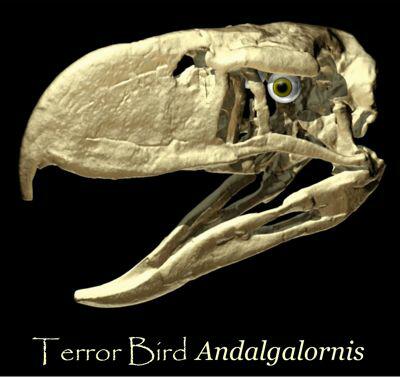|
 |
|
Lawrence M. Witmer,
PhD
Professor of Anatomy
Chang Professor of Paleontology
Dept. of Biomedical Sciences
Heritage
College of Osteopathic Medicine
Life Science Building, Rm 123
Ohio University
Athens, Ohio 45701 USA
Email:
witmerL@ohio.edu
|
|
|
|








 |
|
|
|
| |
|
|
|
|
 Predatory
feeding behavior in terror birds.
The common name for the extinct flightless phorusrhacids is
“terror bird,” an apt name indeed. Phorusrhacids radiated in
South America starting about 60 million years ago, eventually
migrating to North America before going extinct relatively
recently. No one has ever doubted that terror birds were
predators, but without modern-day counterparts, their lifestyles
have been obscure. A new study looked at the 6-million-year-old
skull of Andalgalornis, a patagornithine terror bird
found in northwestern Argentina. CT scanning allowed a
multinational team to probe the inner anatomical structure of
its skull, as well as to perform advanced engineering analyses
of its skull biomechanics. The anatomical studies showed that
terror birds had also evolved very rigid heavy skulls. Bird
skulls generally are lightly built and very flexible with lots
of internal joints, but Andalgalornis had evolutionarily
transformed all those flexible joints into strong rigid beams
with relatively thick bone. Loss of cranial kinesis (internal
flexibility) is rare in birds, and so in terror birds it must be
linked to increasing the rigidity of the skull particularly in
the fore-aft direction. An engineering method called
finite-element analysis allowed different feeding behaviors for
Andalgalornis to be simulated and evaluated. The
simulations told the same story as the anatomy: the skull was
well-adapted to drive the skull straight down, as well as to tug
straight back, but couldn’t tolerate thrashing the head from
side to side. The findings suggest that terror birds used their
powerful necks to jab prey with their rigid bills like a boxer,
using their speed and agility to repeatedly attack and retreat,
but being careful not to grapple with the prey too much which
might damage the tall narrow beak. Once killed by the axe-like
beak, the prey would be swallowed whole or dismembered by
grasping with the hooked beak and pulling straight back with the
neck. Predatory
feeding behavior in terror birds.
The common name for the extinct flightless phorusrhacids is
“terror bird,” an apt name indeed. Phorusrhacids radiated in
South America starting about 60 million years ago, eventually
migrating to North America before going extinct relatively
recently. No one has ever doubted that terror birds were
predators, but without modern-day counterparts, their lifestyles
have been obscure. A new study looked at the 6-million-year-old
skull of Andalgalornis, a patagornithine terror bird
found in northwestern Argentina. CT scanning allowed a
multinational team to probe the inner anatomical structure of
its skull, as well as to perform advanced engineering analyses
of its skull biomechanics. The anatomical studies showed that
terror birds had also evolved very rigid heavy skulls. Bird
skulls generally are lightly built and very flexible with lots
of internal joints, but Andalgalornis had evolutionarily
transformed all those flexible joints into strong rigid beams
with relatively thick bone. Loss of cranial kinesis (internal
flexibility) is rare in birds, and so in terror birds it must be
linked to increasing the rigidity of the skull particularly in
the fore-aft direction. An engineering method called
finite-element analysis allowed different feeding behaviors for
Andalgalornis to be simulated and evaluated. The
simulations told the same story as the anatomy: the skull was
well-adapted to drive the skull straight down, as well as to tug
straight back, but couldn’t tolerate thrashing the head from
side to side. The findings suggest that terror birds used their
powerful necks to jab prey with their rigid bills like a boxer,
using their speed and agility to repeatedly attack and retreat,
but being careful not to grapple with the prey too much which
might damage the tall narrow beak. Once killed by the axe-like
beak, the prey would be swallowed whole or dismembered by
grasping with the hooked beak and pulling straight back with the
neck.
|
A technical article
was published on 18 August 2010 in the open-source, feely
available, online journal
PLoS ONE.
• Download a PDF of the published article:
Degrange, F. J., C. P. Tambussi, K. Moreno, L. M. Witmer, and S.
Wroe. 2010. Mechanical analysis of feeding behavior in the
extinct "terror bird" Andalgalornis steulleti
(Gruiformes: Phorusrhacidae). PLoS ONE 5(8): e11856.
doi:10.1371/journal.pone.0011856
•
Download a PDF of
the Supplementary Information
|
Additional Resources:
New Release, Images, Movies, & Animations |
|
|
 |
This website provides supplementary information as an
adjunct to the published paper. Witmer, with the skilled
assistance of
Ryan Ridgely, is responsible for
the content of the website. Content provided here is for
educational and research purposes only, and may not be used for
any commercial purpose without the permission of
L. M. Witmer and other
relevant parties.
This project was funded by grants from the
National Science
Foundation. |
|
|